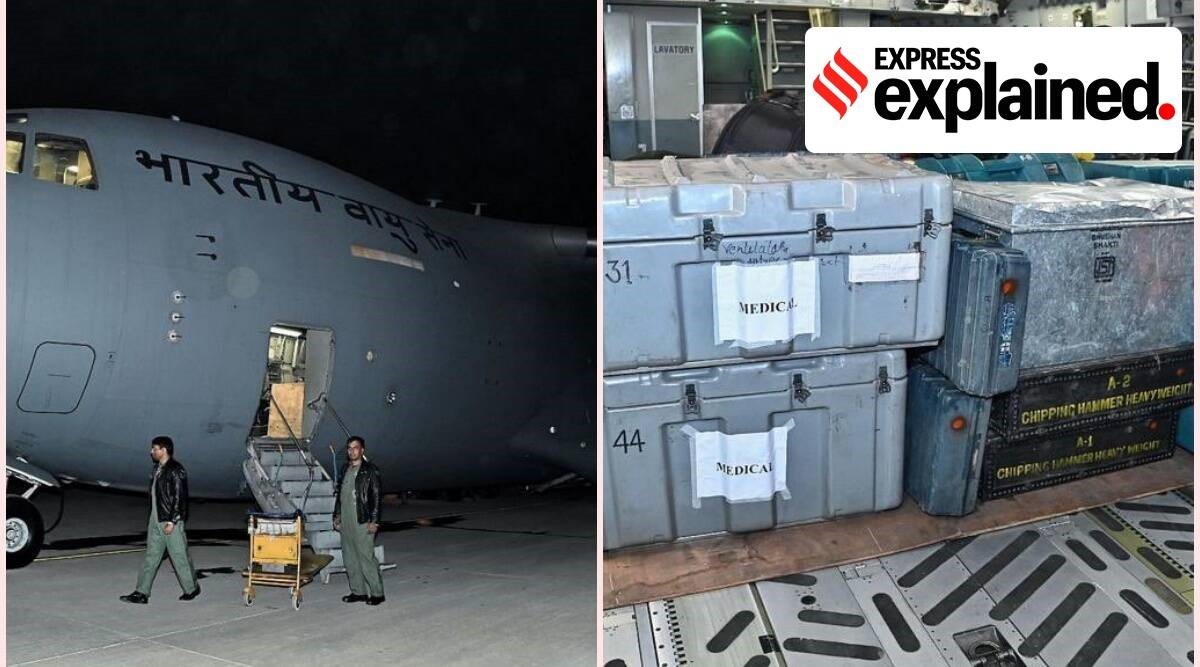INDIA’S ROLE IN HELPING NATURAL DISASTER-HIT COUNTRIES

Disclaimer: Copyright infringement not intended.
Context: In a bid to provide relief to the quake-hit Turkey, India is sending an Army medical team, National Disaster Relief Force (NDRF) personnel, and medical supplies. The West Asian nation was struck by a series of massive earthquakes killing over 5,000 people and injuring thousands.
Details:
In the last 15 years, India has carried out several disaster relief operations and emerged as a leading actor during such emergencies, especially in its neighbourhood.
What are the previous instances of India sending aid to natural disaster-hit countries?
- The United States of America:An Indian Air Force IL-76 aircraft delivered 25 tonnes of relief supplies for the Hurricane Katrina victims at the Little Rock Air Force Base, Arkansas on September 13, 2005.
- Maldives:After the 2004 Tsunami, the Indian government announced a composite package worth five crore rupees. Under “Operation Castor”, 50 sorties were undertaken and four aircraft and two Naval ships were engaged in relief operations.
- Sri Lanka:India sent its forces to carry out rescue operations, called “Operation Rainbow”, in Sri Lanka hours after the Tsunami struck the country on December 26, 2004.
- Myanmar:When cyclone Nargis hit Myanmar in 2008, India was among the first countries to send aid to them.
- Japan:The 2011 Tsunami wreaked havoc in Japan. Apart from providing relief materials, India also sent 46 members of the National Disaster Response Force (NDRF) to search and rescue in the town of Onagawa.
- Nepal:In the aftermath of the 2015 earthquake, the NDRF deployed 16 of its urban search and rescue (USAR) teams.
Summary of types of Indian humanitarian aid and related destinations (2018-2022):
|
Support provided in the form of: |
Examples of recipient countries |
|
Food and grain |
Bangladesh, Syria, Afghanistan, Comoros, Madagascar, Sudan, South Sudan, Djibouti, Lebanon, Malawi and Eswatini |
|
Medicines, artificial limbs, and medical equipment (including ambulances) |
Mozambique, Syria, Yemen, Somalia, Uganda, Tanzania, Madagascar, Swaziland, Kenya, Namibia, El Salvador, Zimbabwe, Comoros, Madagascar, Palestine, Kyrgyzstan, Kazakhstan, and Armenia |
|
Vaccines |
Tanzania (polio), Covid-19 vaccines to approx. 51 countries |
|
Other relief supplies to citizens (non-food items) |
Cambodia, Vietnam, Fiji and Democratic Republic of the Congo |
|
Other forms of support (restoration of waterworks in war affected area) |
Iraq |
Analysis:
- Recent decades have seen a slow but steady rise in the role that Global South States, including India, have begun to play in responding to emergencies either by providing funds or sending supplies to affected countries.
- This assistance has included support in response to natural disasters, during long-term complex emergencies and support provided in post-conflict, post-disaster and pandemic situations.
- While engagement in humanitarian response is a relatively new facet of Indian foreign policy, Indian government support to other countries (much, but not all, of which is concentrated in neighbouring States) is not new.
- Indian overseas development assistance has indeed been an important part of Indian foreign policy since the country’s Independence and is closely associated with foreign policy priorities particularly under a South-South Cooperation (SSC) framework.
- The past two decades have seen substantial increases in Indian bilateral aid; with this expansion has come increased support for international humanitarian response.
Determinants of Indian humanitarian aid:
- India’s humanitarian support has been extended to countries in need for a variety of reasons.
- The government acknowledges the importance of the UN’s four fundamental humanitarian principles of humanity, neutrality, impartiality and independence.
- India is also a signatory to all four Geneva Conventions and participated in the 2016 World Humanitarian Summit.
- The SSC’s foreign policy principle also informs and prompts India’s humanitarian actions, with India often seeking to respond in accordance with the expressed needs of recipient country governments.
- The current government has also frequently invoked certain values enshrined in Hinduism and Buddhism in recent years as part of its narrative on why it provides humanitarian aid.
- This practice of using terms from religions founded in or around present-day India in its aid diplomacy contributes to the current government’s style of “engaging with Hinduism in diplomatic representation”.
- This government has also been fervent in naming its humanitarian missions. For example,:
- Samudra Maitri was an operation that helped Indonesians during the October 2018 earthquake and tsunami;
- Operation Insaniyat encompassed India’s support to Rohingya populations during the September 2017 refugee influx in Bangladesh;
- Operation Sahayata included support extended to Mozambique in 2019 after Cyclone Idai,
- Operation Vanilla was undertaken in Madagascar in 2020 after the floods and Operation Devi Shakti included the evacuation of Indians and Afghan nationals in 2021 after the Taliban takeover.
- Domestic considerations sit alongside more traditional foreign policy interests.
- Other reasons for providing assistance cited by officials include the maintenance of historical and friendly ties with recipient States and the fulfilment of obligations in some cases.
- India’s support in the form of wheat and rice has been described as “Grain diplomacy” in a Parliament Committee report.
- GoI notes that this form of diplomacy has been “institutionalised for implementation” by the MEA. This, again, helps India in highlighting its importance in the region in ensuring food security in times of crises.
- Claims of purely principled humanitarian responses, while not without some merit, should also be considered in the context of India’s geopolitical interests.
- India often prioritises its immediate neighbourhood – in part reflecting its capacity to respond quickly there, but also reflecting its regional role as “big brother” to some neighbouring States as well as its antagonistic relations with Pakistan (particularly with respect to providing assistance to Afghanistan prior to the Taliban takeover), while competition with China remains an on-going consideration in India’s ODA programme in general, including its humanitarian responses.




.jpeg)


1.png)
